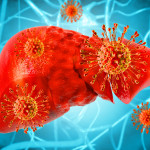For people coinfected with HIV and hepatitis C virus (HCV), waiting to start HCV treatment until they progress through the levels of liver fibrosis raises the risk of liver-related complications and death, according to new computer modeling estimates.
Fibrosis, or scarring of the liver, is divided into five stages. F0 means there is no fibrosis, F1 through F3 signify fibrosis with increasing severity, and F4 indicates cirrhosis.
The researchers projected that, when compared with treating all coinfected people immediately after they’re diagnosed with hep C, delaying treatment for a year leads to 14 additional cases of liver-related deaths for every 1,000 people, and waiting until individuals reach fibrosis stages F2, F3 or F4 leads to a respective 43, 142 and 418 additional deaths.
The estimated likelihood that people will experience cirrhosis, liver cancer or liver-related death is projected to increase steadily as treatment is delayed, with a great upswing in the later stages of fibrosis.
“Our study really shows how deferring HCV therapy can be problematic in HIV-coinfected individuals,” says Cindy Zahnd, an MSc candidate and research assistant at the Institute of Social and Preventive Medicine at the University of Bern in Switzerland, who headed the computer modeling study.
Zahnd also notes that the paper’s conclusions “can be applied to other patient populations who have risk factors for liver disease progression that are independent of HCV: alcohol consumption, other coinfections, metabolic liver disease, consumption of drugs that are [toxic to the liver], etc.”
Dangers of Delaying Hep C Treatment





Comments
Comments